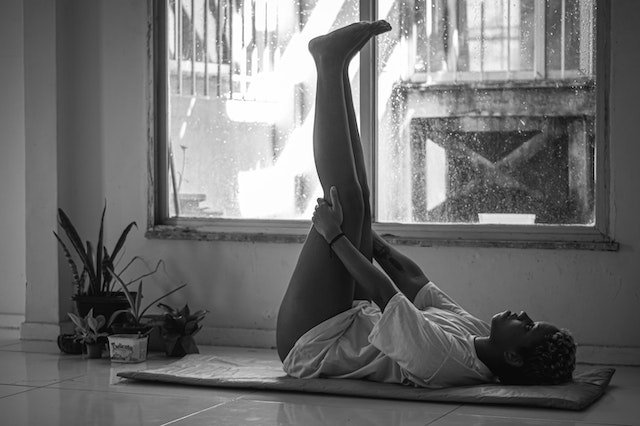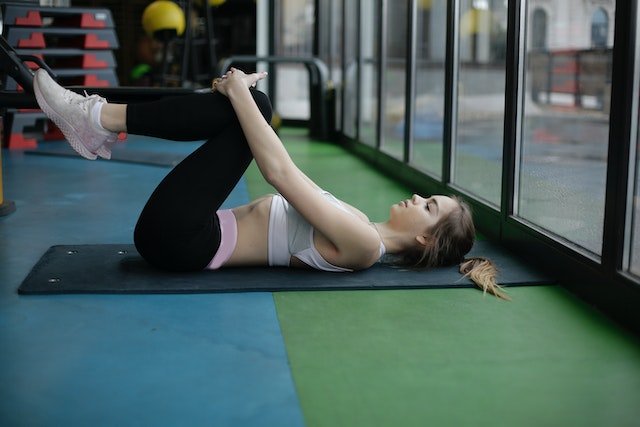
Why Do Lying Leg Raises Hurt My Legs More Than My Abs? Find Out Here
There is nothing quite like the burn you feel in your abs after doing a set of lying leg raises. However, if you’re like many people, you may find that this exercise does cause pain and discomfort in your knees and legs.
It’s something that often occurs for various reasons during the exercise. It is easy for your legs to take over and rely on hip flexors instead of engaging the core to do the work.
So, why is this the case? Is there anything you can do to reduce this pain? Read on to find out more.
Why do lying leg raises hurt my legs more than my abs?
The most common reason why lying leg raises causes pain and discomfort in your legs instead of your abs due to poor technique. Your body may be using your legs instead of relying on the core to do the work. This causes your hips flexors and quadriceps to take over, leading to pain in your knees and thighs. It may also be that you are overweight, and your core might not be strong enough to adequately lift your legs without relying on the rest of your body, which can put a strain on the legs and strain the knees. You may also find that if you are not keeping your back flat or using your hands as leverage, this can cause pain in the legs and hips. If you have recently pulled a muscle or have tight hamstrings and hip flexors, this can also cause pain in the legs. Finally, you may be moving too quickly and sticking your head up when you do the exercise which can cause strain in the neck and shoulders, as well as pulling on your hamstrings which can cause leg pain.
Muscles in use
To perform a lying leg raise, the primary muscles used are your abdominals and hip flexors, which work to lift your legs up and down.
Your glutes, erector spinae, and hamstrings work to stabilize the spine and hips and ensure proper form.
This sounds relatively simple, right? Well, it’s not as clear cut as you’d expect due to the fact that you must use your core to do the exercise properly and not allow other muscles to take over.
Even though this is a fairly simple exercise to do, execution is key to ensuring that you are engaging the correct muscles for this exercise.
Poor technique
One of the main reasons why people experience pain in their legs after performing a lying leg raise instead of their abs is due to poor technique.
It is easy for your legs to take over and rely on hip flexors instead of engaging the core to do the work.
In order to ensure that you are doing the exercise correctly, you should make sure that your back is flat on the ground and your stomach is engaged as you perform the movement.
You should also avoid putting your hands under your lower back as leverage or sticking your head up, as this can cause pain in the neck, shoulders and hamstrings.
You aren’t using core
This is very obvious but needs mentioning…you must use your core to perform lying leg raises!
If you are not engaging your abdominals and lower back, then you are likely relying on your legs to do all the work.
Instead of using momentum from your legs and hips, focus on engaging your core muscles and keeping a flat back.
This will help to ensure that you are using the correct muscles for the exercise and reduce the strain on your legs.
If you don’t typically work out, it will take some time to get used to the exercise and for your body to engage the correct muscles.
It might be more beneficial to start with single leg raises to help you get used to the movement and use your core correctly.
Either way, be patient and focus on form and technique before upping the difficulty.

Legs take over
Another reason why the lying leg raise may be causing pain in your legs instead of your abs is that your legs are taking over.
Your body may be using your legs instead of relying on the core to do the work. This causes your hips flexors and quadriceps to take over, leading to pain in your knees and thighs.
In order to ensure that you are engaging the correct muscles for this exercise, it is important to ensure that you are focusing on using your core and avoiding the temptation to use your legs to assist.
There are a few ways you can change the exercise to make it easier and allow you to build your strength up.
You can do single leg raises, as this will reduce the strain on your legs and allow you to focus more on engaging your core.
You can also try alternate leg raises, as this will ensure that you are engaging the correct muscles for each leg and not relying on one to do all the work.
Related: Why Do My Hip Flexors Hurt When I Do Ab workouts?
Hip flexors take over
Another reason why the lying leg raise may be causing pain in your legs instead of your abs is that your hip flexors are taking over.
Your hip flexors are a group of muscles located in your upper thigh and lower abdomen that work to lift your legs up and down. If your hip flexors are overworked, it can cause pain in your legs and hips.
This kind of discomfort can be quite common, especially in those who are new to exercise or those who are not used to using their hip flexors.
In order to ensure that you are engaging the correct muscles for this exercise, it is important to focus on keeping your back flat and engaging your abdominals as you lift your legs.
If this still proves too difficult, you can try doing the exercise with a Swiss ball or box held between your legs to reduce the strain on your hip flexors.
Is your weight an issue?
It is important to note that if you are carrying excess weight, this can also be a contributing factor to the discomfort you may feel in your legs during a lying leg raise.
The additional weight can place more strain on your muscles and joints, making it more difficult for you to lift your legs and engage your core.
If weight is an issue for you, then you may already have a weaker core, which will make the exercise more difficult and can cause more pain in your legs.
If this is the case, it may be beneficial to focus on losing weight in order to make the exercise easier, try an alternative exercise or maybe do a laying bent leg raise.
Have your feet flat on the floor with your knees bent, as this will reduce the amount of weight you are lifting.
Raise one leg until your shin is parallel to the floor and your knee is at a 90º angle, alternate your legs and increase the intensity gradually, as this will help you to build up your strength and eventually be able to perform the exercise with both legs raised.
This might not sound very difficult to many, but if your core strength needs work, you need to build up slowly in order to reduce the amount of strain and injury to your legs.
Tight hamstrings
Another cause of discomfort during the lying leg raise could be tight hamstrings.
Your hamstrings are a group of muscles located in the back of your thighs which work to move your legs both up and down.
Tight hamstrings are quite common and can be caused by a lack of stretching or overtraining, plus if you aren’t used to training and don’t do much exercise and lead a sedentary lifestyle, then they won’t have been utilised for some time.
Meaning they will be tight and unable to support the movement of your legs properly. Tight hamstrings can lead to pain in your legs, as they are overworked when performing the lying leg raise and can cause strain on your knees and hips.
Tight hamstrings can cause discomfort, as they are unable to stretch and contract properly.
In order to avoid this, you can stretch your hamstrings before and after performing the lying leg raise. This will help to loosen them and reduce the amount of strain placed on your legs during the exercise.
Pulled muscle
If you’re doing leg raises and your legs are hurting, you may have pulled a muscle. Pulled muscles can be caused by overworking your leg muscles or by doing the exercise incorrectly.
Similarly, if you are recovering from any kind of quad, hip or abdominal injury, then the pain you are feeling could be due to the strain of the exercise on an already injured area.
It’s important to listen to your body and if you are in pain due to any kind of injury, then it’s best to rest and not continue with this exercise until the area has healed.
If you experience weakness or pain while working out, you may have pulled a muscle or been injured in some other way.
In this case, it is recommended to rest and apply ice to the area to reduce inflammation and pain.
You should also see a doctor if your pain persists, as this could be a sign of a more serious injury.
Not keeping back flat
When doing the lying leg raise, it is important to keep your back flat and maintain good posture throughout the exercise.
If you are failing to keep your back flat, then you may be using the wrong muscles or not engaging your core correctly.
Tilting your pelvis can cause you to use your hip flexors instead of your core, which will place more strain on your legs and increase the pain.
If you have a slight curve in your back, then this is okay, but you should focus on keeping it straight and engaging your abs fully to reduce the amount of strain placed on your legs.
This can cause an imbalance in your body and can lead to pain in your legs, as they will be taking more of the strain than your core.
In order to avoid this, it is important to focus on engaging your core and keeping your back flat throughout the exercise.

Dont use hands as leverage
Using your hands as leverage when performing the lying leg raise can also cause pain in your legs.
If you find the exercise challenging, putting your hands under your lower back might feel like the exercise is easier, but this can actually put more strain on your legs and cause pain.
When using your hands as leverage, you are putting the majority of the weight on your legs and not engaging your core as you should be, which can cause strain and pain in the muscles.
Using your hands as leverage can place more strain on the muscles in your legs and can cause pain.
It is important to keep your hands at your sides or behind your head in order to ensure you are engaging your core correctly.
By doing this, you will be taking the strain off your legs and using your core to perform the exercise properly.
Related: Is there any benefit from flexing your abs whenever you can?
Sticking head up
Sticking your head up when doing the lying leg raise can also cause extra strain on your legs.
Once again, if you aren’t used to the exercise it can feel natural to lift your head to get extra leverage.
However, this is not the case. When you are performing this exercise, it is important to keep your head in line with your spine.
Sticking your head up can cause tension in the muscles in your neck and shoulders, and can also cause you to lose balance during the exercise.
Not only does sticking your head up during this exercise cause extra strain on tight hamstrings, but it will also make it more difficult to lift your legs as high as normal.
It is important to keep your head in line with your spine during the exercise and to avoid sticking your head up in order to reduce any extra strain on the muscles in your legs.
Keep the back of that head pressed down into the floor and let your core do the work.
Alternative exercises
If you are finding that the lying leg raise is causing too much pain in your legs and you would like to focus more on working your core, then there are other exercises you can try.
These include plank variations, mountain climbers and side plank. These exercises target the core and help to strengthen it.
By strengthening your core, you will be able to perform the lying leg raise correctly, with less strain on your legs. You will also be able to lift your legs higher and get a better workout overall.
If you opt for leg raises or any of these substitutes, be certain to perform the movement slowly and with purpose. Do not attempt to rush through the exercise.
Performing the exercise too quickly can place more strain on your legs and cause pain.
It is important to use proper technique and to focus on engaging your core to ensure you are getting the best results from your workout and avoiding any unnecessary strain or pain.
Final thoughts…
If you are experiencing pain in your legs when performing the lying leg raise, it is likely due to poor technique or using your hands as leverage.
It is important to keep your back flat and engage your core throughout the exercise to take the strain off your legs.
Sticking your head up during the exercise can also cause extra strain on your legs and make it more difficult to lift your legs as high as normal.
If you are finding the lying leg raise too painful, there are other exercises you can try that target the core and help to strengthen it.
By focusing on proper technique, engaging your core and avoiding any extra strain, you can ensure you are performing the exercise correctly and getting the most out of your workout.
Do you experience this issue when doing leg raises? Let us know in the comments below.


